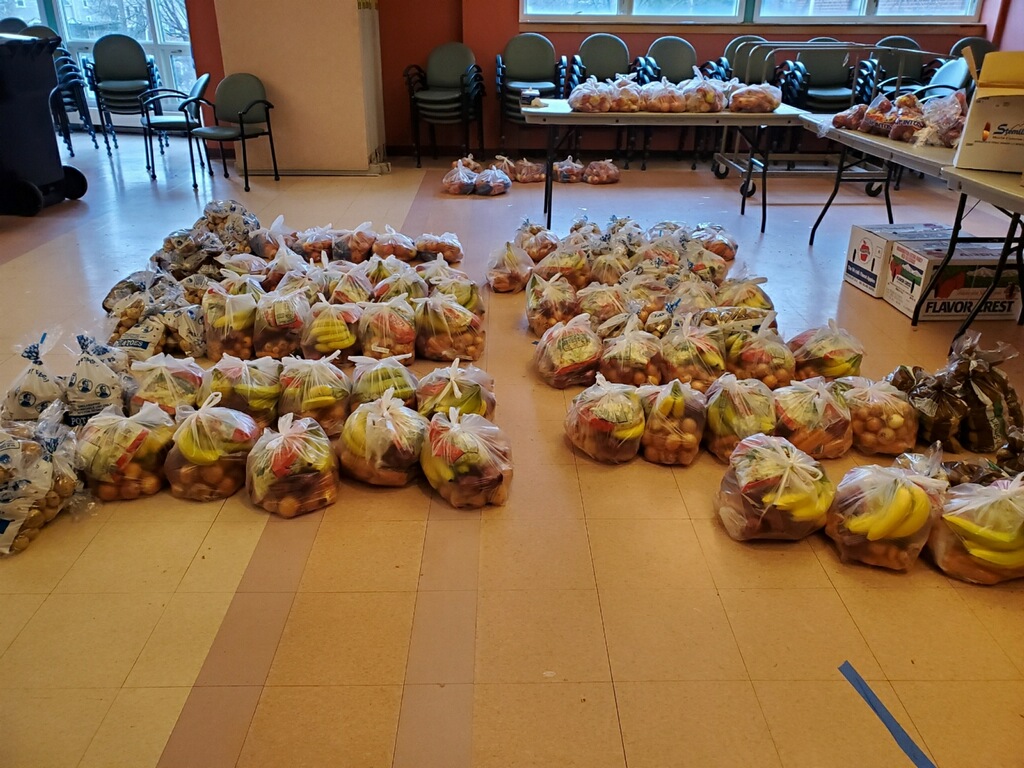“What are we going to do when the schools and pantries close?” asked Alanna Mallon, Cambridge’s Vice-Mayor and Food For Free’s K-12 Strategic Lead. It was mid-March and Sasha and Alanna were talking about the just-announced closure of Cambridge schools, and the expected closure of many of the city’s food pantries.
Could we deliver food to everyone who would need it? It would be hundreds—maybe thousands—of households. Could we make it happen?
It took Food For Free, the City of Cambridge, and the Greater Boston Food Bank all working together, but the week of March 17 deliveries began.
That first week, we reached 900 households. By the end of April, we were delivering to more than 1,900 each week.
It’s been a massive undertaking. Over 600 volunteers have pitched in, packing groceries, making deliveries, taking the temperature of other volunteers, or even monitoring the door for hours at a time to let people in. Our heroic site-leaders—those volunteers who manage the grocery-packing each day—have been critical, working long days on their feet with amazing competence, creativity, and good cheer.
If you’ve worked one of these shifts, you’ve seen Steph and/or Ali—the linchpins of the program—working tirelessly to keep it running smoothly. These two have been organizing volunteers, ordering food, solving problems, and answering so many questions every day this program has run.
You may have missed Ryan and his operations team, who pick up thousands of pounds of food every day from the Greater Boston Food Bank, delivering it to our packing site at the Senior Center by 8:30 each morning. Some days, they drop off a second delivery in the afternoon, quickly, quietly. Five thousand pounds of food delivered in just a few minutes and they’re out the door again, back to their regular jobs of bringing food to the other agencies we serve.
By the end of April it became clear that, without modifications, the program would expand beyond our ability to manage it. Food For Free’s management team again put their heads together with our partners at the City and with our nonprofit partners in the Cambridge Food Pantry Network to propose three modifications that we hoped would bolster the program and preserve its ability to serve those who needed it most:
• We would promote the services of local food pantries more heavily, encouraging those who were able to visit these pantries in favor of signing up for deliveries, thereby keeping more delivery slots open for seniors and those who were unable to make it to pantries.
• Vice Mayor and Food For Free staff member, Alanna Mallon would work with staff at the Cambridge Economic Opportunity Committee (CEOC) to call every household on the current delivery list to help eligible people enroll for SNAP and P-EBT benefits.
• We would offer households within 1.5 miles of Market Basket, if not headed by seniors, $30/week in grocery store gift cards in lieu of grocery delivery. For those able to visit the store, this would give them the ability to select their own groceries, and to include the kinds of highly perishable or delicate items (think: eggs) that are impractical for our volunteers to deliver. Food For Free rolled this option out on April 27. We are sharing the expense of these gift cards with the CEOC and the City of Cambridge.
It is our hope that this three-pronged approach will offer more appealing alternatives to families who are able to get to pantries or to grocery stores on their own—alternatives that enable them to choose their own groceries on their own schedules—while preserving enough slots on the Grocery Delivery program for those who really need them: seniors, people with disabilities, those with active cases of COVID-19, and those who are quarantined post-exposure.


